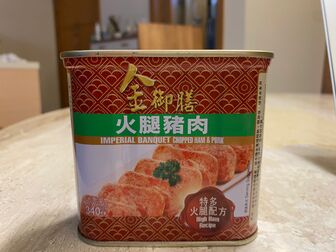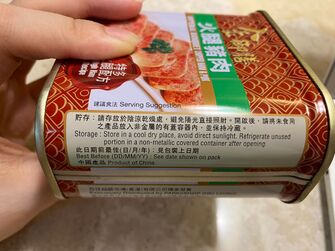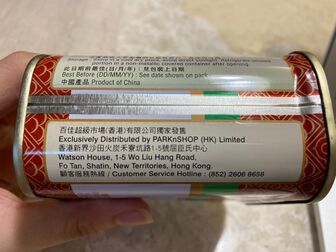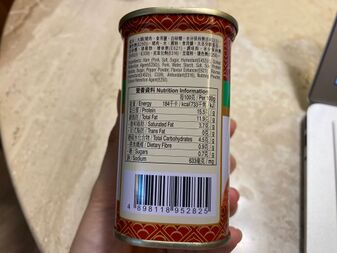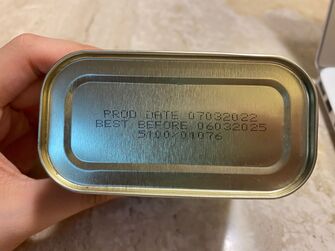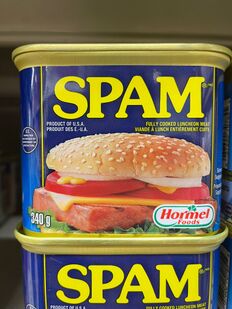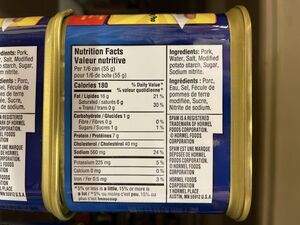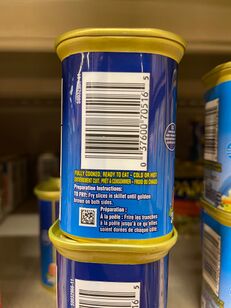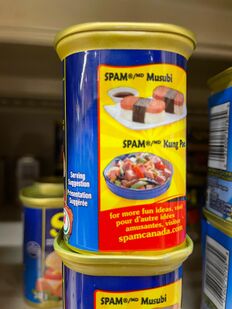Course:FNH200/Projects/2022/Spam
Introduction
The term luncheon meat comes from SPAM. SPAM is an abbreviation of “Specially Processed Assorted Meat”. SPAM is a kind of cooked canned meat, produced by Hormel Ltd in the States during the 1930s. During the period of the Great Depression, canned SPAM was cheaper than conventional beef or pork, making it a popular choice of meat consumption among New Yorkers when they can’t afford expensive fresh meat. Also, SPAM was extremely popular when government officials and top brass from companies organized their luncheon. Bit by bit, luncheon meat replaced the name of SPAM. After that, when SPAM was first introduced to the Chinese market, it was marketed as luncheon meat in mandarin. Later, the term “luncheon meat” became a more common name for SPAM. [1] Luncheon meats are known as cold cuts, cooked meat, sliced meats and deli meats. It is a kind of precooked or cured meats that are served in slices, cold or hot. They can be bought in fresh slices or vacuumed packs/ cans.
History
The history of Luncheon Meat is synonymous with the history of Spam. As the first luncheon meat product of its kind, the introduction of Spam heralded a new category of food product.
Spam is a brand of canned luncheon meat that was introduced by the Hornet Foods Corporation in 1937. Invented by Jay Hormel, Spam as a product was conceived to help distinguish and diversify the business of his father’s eponymous company. At the time, Hormel Foods dealt mainly with fresh meat products that failed to stand out in the marketplace against similar competitors. The fresh meat industry was also season bound in its supply chain which meant that Hormel couldn’t produce and sell new goods year-round.
Despite the Hormel company enjoying prior innovations such as introducing the first canned ham in 1926 and canned chicken in 1928, stiff competition from imitators forced Hormel to invent more. Through experimentation, Jar Hormel stumbled on a product formulation that changed his family fortune. Early meat canning techniques developed deficiencies like cell walls breaking down and releasing moisture from the meat, resulting in a dry meat produced sitting in its liquid in the can. The innovation in Spam laid in its processing that resulted in a moist product. The product formulation also enabled Hormel to blend underutilized cuts of meat like pork shoulder with ham to reduce costs.
Although early marketing efforts were aimed at housewives and domestic households, Spam found prominence in its role in World War 2. The logistics of America fighting a two-front war effort made supplying fresh meat to its troops complicated. Instead, Spam and other luncheon meat products were introduced as fresh meat substitutes in American military ration. When the war ended, Spam’s popularity exploded domestically as soldiers returned home and brought with them their newfound taste for Hormel’s luncheon meat product. Spam and other luncheon meat products thus became part of the American palette and from there spread to global consumption.
Manufacturing process
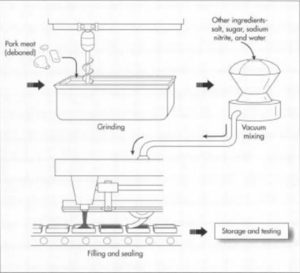
STEP 1: FROM DEALERS TO PLANT
Meat is purchased from dealers and brought into the plant and cut apart. Different body parts are processed separately. For port shoulders, they are put into a powerful hydraulic press that squeezes the meat off the bone, which then the deboned meat is put into a large basket. For ham, it must be cut away from the bone by hand, which meat-cutters remove and sort the meat from the shanks in the ham trim lines. The whitest, fattiest pieces are put into a basket marked "white," while meatier pieces are hand-sorted into one marked "red." The baskets then remain in a refrigerated area until they are needed. [2]
STEP 2: GROUNDING THE MEAT
The baskets of meat are transferred to a crane-like machine then dumped into a large metal trough equipped with a drill bit. There, the drill bit thoroughly grinds the red and white pieces of meat. The batch is weighed (usually about 3,628 kg) and passed under a metal detector to catch sharp objects like a stray knife or mixing component. A small sample of SPAM is analyzed to ensure it has the right portion of pork to ham and white to red pieces.[2]
STEP 3: MIXING OF THE MEAT
The ground meat is then sorted into several vacuum mixers, which are equipped with a refrigerated ammonia outer core that brings the meat temperature down to below freezing (0°C). Then, other ingredients in SPAM (salt, sugar, water, and sodium nitrite) are added. The mixer lid is closed, creating an airtight seal, and the batch is mixed. The inducing of the vacuum, chilling of the meat, and the salt added are all done to reduce the amount of juice released by the meat when cooked. If too much liquid is released, the can would contain a large amount of gelatin.[2]
STEP 4: FILLING THE CANS
Machines push upside-down Spam cans off storage pallets one layer at a time. The plain silver cans are pushed onto a conveyor belt and sent toward the filler.
Nearly 454 kg of SPAM is manually unloaded from the mixer, dumped into receivers, and fed through pipes to reach the cone-shaped can fillers. As the cans travel underneath the fillers, a device picks each one up and deposits the raw, ground SPAM into the can.[2]
STEP 5: COOKING OF THE MEAT
The can is sealed at a closing machine, which is then stamped with an identifying code so that the product can be traced back to the manufacturer. The closed cans are delivered in a line to a six-story-tall hydrostatic cooker. SPAM is cooked in the can by very hot water within the cooker. An arm swings out and pushes 24 cans onto a shelf, which moves upward, and an arm swings out and pushes another group of cans onto a shelf. The cans are heated, sterilized, washed, and cooled.[2]
STEP 6: LABELING OF THE CANS
The cans are cool and ready for labeling. The labels sit at the end of the cooker in long rolls. An automatic labeler attaches a polypropylene film label on each can, and the labeler cuts the label to the correct length.[2]
STEP 7: BOXING OF THE CANS
The cans are now ready for boxing. 24 cans are fed onto flat pieces of cardboard, and a box is formed around the cans using the cardboard. The boxes are moved, and when a palette is filled with boxes, the entire pallet is shrink-wrapped. The cans are stamped with a date and other identifying numbers. A huge robot crane transfers the pallet to a rack of shelving in the building. When the pallets get to the loading dock, they are hoisted into the shelves by machines.[2]
STEP 8: QUALITY CHECK
The SPAM cans cannot be shipped out for 10 days. One of every 1,000 cans produced must undergo extensive testing to make sure the meat was properly cooked. If there are no problems, the cans may be sold afterwards.[2]
Major Food Additives in SPAM: Sodium Nitrites
Sodium nitrites are the only food additives in SPAM. Nitrites are a major ingredient in cured meats. This is because nitrites act as an antimicrobial agent, which is important in preventing the growth of disease-causing bacteria, specifically Clostridium botulinum.
A discovery in the 1960s showed that nitrites could potentially be harmful to humans when domestic animals fed with food that had high levels of sodium nitrite were dying of liver failure. A later study found that nitrites combined with amines produces nitrosamines, which are known carcinogens.
In order to try and regulate the use of nitrites in cured foods, the US Department of Agriculture (USDA) allow a maximum 200mg/kg of residual nitrite in its products.
Although alternatives to nitrites in cured meats have been extensively researched, none of them have been approved as a complete substitute to nitrites. Examples include ascorbate, tocopherol, irradiation, and lactic-acid-producing organisms.[3]
Comparison of Luncheon Meat in Canada and Hong Kong
In this investigation on Luncheon Meat, we will be further comparing Luncheon Meat in Canada and Hong Kong with regards to their ingredients, additives, labeling and regulations.
Pictures of Imperial Banquet Chopped Ham & Pork (Hong Kong)
Pictures of SPAM (Canada)
Labeling and Regulations
| Imperial Banquet Chopped Ham & Pork (Hong Kong) | SPAM (Canada) | |
| Ingredients | Ham (Pork, salt, sugar, Humectant(E452(i)), Colour Retention Agent(E250)), Pork, Water, Starch, Salt, Soy Protein Isolate, Sugar, Pepper Powder, Flavour Enhancer(E621), Flavour, Humectant(E452(i), E339), Antioxidant(E316), Nutmeg Powder, Colour Retention Agent(E250) | Pork, Water, Salt, Modified potato starch, Sugar, Sodium nitrite |
| Purpose of additives |
|
|
| Language | Chinese and English | French and English |
| Storage instructions | Store in a cool dry place, avoid direct sunlight. Refrigerate unused portions in a non-metallic covered container after opening. | Not required: Storage life >90 days |
| Produce Date | See date shown on package | See date shown on package |
| Best Before Date | See date shown on package | See date shown on package |
| Identity/ principal place of business | Exclusively Distributed by PARKnSHOP (HK) Limited | Registered trademark of Hormel Foods Corporation |
| Legibility and location | Product of China, Watson House, 1-5 Wo Liu Hang Road, Fo Tan, Shatin, New Territories, Hong Kong | 1 Hormel Place
Austin, MN 55912 U.S.A |
| Nutrients list | Energy (kjoules/ kcal)
Protein Total fat (saturated and trans) Total carbs (dietary fibre and sugar) Sodium |
Calories (kcal)
Fat (saturated and trans) Carbohydrate (fibre and sugars) Protein Cholesterol Sodium Potassium Calcium Iron |
| Net Quantity | 340g | 340g |
| Sweeteners | Not applicable | Not applicable |
| Nutrient content claims and diet-related health claims | Not applicable | Not applicable |
Food Labeling
According to the Schedule 3 of the Food and Drugs (Composition and Labelling) Regulations, the name of the food, “best before” or “used by” date, condition of storage and usage instruction, name and address of manufacturer and volume of food is required to be labelled on any pre-packaged food in Hong Kong. [7] Energy and nutritional levels should be shown per 100g, per 100ml, per one serving or per pack. Ingredients should be listed descending order by weight. Additives are required to be listed by either its functional class with their specific name or by the identification number set by the International Numbering System for Food Additives. Food labels should be in English or Chinese or both languages. [8]
When compared to labeling requirements in Canada, nutritional information is referred to a standardized serving size of 100g or by total weight of the product. Recommended daily intake percentage (%DV) of all 13 major ingredients and nutrients are also required to be included. 2,000 calories is used as a general guide for nutrition advice per day, with 5% DV or less is a little and 15% DV or more is a lot. Instead of Chinese and English, it is mandatory to show French and English on their labels.[9] Both Hong Kong and Canada food labels require “Best before” dates and specification of components that contain any allergens, gluten, or sulphites. Cholesterol, potassium, calcium and iron levels is required on Nutrient Facts Table in Canada but missing from the food label of Imperial Banquet Chopped Ham & Pork as it is not required to specify such levels under Hong Kong Food Safety Food Labeling requirements.
Food Regulations
According to Canada Food Regulations, Luncheon Meat is meat that is comminuted, cooked and pressed into shape. It may contain 3% sodium of the finished product and should have at least 11% of total protein content. They could also be preserved meat or meat placed in a hermetically-sealed container. Only Ingredients that are permitted by Regulations are prepared hams and pig shoulder. Modified potato starch is used as a meat binder. [10]
Nutrient Composition
When comparing the ingredients of Imperial Banquet to Canada Food Regulations, it contains the preservatives E452, or Sodium Polyphosphate and Monosodium Glutamate(MSG). These two additives do not count as food additives in Regulations of Canada. MSG is considered as a flavour enhancing ingredient in Canada and is recommended to be used within the Good Manufaturing Practice (GMP) level.[11]
Not only that, Imperial Banquet contain many additives as different agents serve a variety of purposes such as containing moisture in meat and suppressing the growth of spoilage-causing bacteria. SPAM on the other hand has a relatively simple ingredient list. But when it comes to sodium, SPAM contains much more sodium than Imperial Banquet. SPAM luncheon meat contains 1018 mg per 100g, and Imperial Banquet contains 633 mg per 100g. A lot of articles often evaluate which brand of luncheon meat is healthier based on the amount of sodium per 100g.[12]
Safety Concerns
The International Agency for Research on Cancer (IARC), the cancer agency of the World Health Organization (WHO), released an evaluation result about the carcinogenicity of the consumption of red meat and processed meat on 26 October 2015.
- Processed meat (refers to meat that has been transformed through salting, curing, fermentation, smoking, or other processes to enhance flavor or improve preservation. Examples include ham, sausages and luncheon meat) was classified as “carcinogenic to humans” (Group 1), based on sufficient evidence in humans that the consumption of processed meat causes colorectal cancer. The experts concluded that each 50 gram portion of processed meat eaten daily increases the risk of colorectal cancer by 18%.
- The risk of developing colorectal cancer for an individual because of their consumption of processed meat remains small, but this risk increases with the amount of meat consumed.
The IARC classifications describe the strength of the scientific evidence about an agent being a cause of cancer, rather than assessing the level of risk. Processed meat and tobacco smoking have been classified in the same category as causes of cancer (Group 1, carcinogenic to humans), but this does not mean that they are equally dangerous. About 34 000 cancer deaths per year worldwide are attributable to diets high in processed meat. These numbers contrast with about 1 million cancer deaths per year globally due to tobacco smoking. [13]
Exam Question
Which additive in Luncheon Meat acts as an antimicrobial agent?
A. Sodium Chloride
B. Monosodium Glutamate
C. Sodium Nitrite
D. Sodium Phosphate
Answer: C. Sodium Nitrite
Explanation: Nitrites act as an antimicrobial agent in cured meats, and sodium nitrite is used in luncheon meat to prevent the growth of C. Botulinum.
Our question should be used in the exam as it draws on knowledge from module 4.7 Food Additives. It is an important topic that has been covered in class a while ago, so it would be great to refresh our classmates memory on the usage and purpose of different food additives. In addition, food additives have been greatly discussed and it relevant to our lives on a daily basis.
References
- ↑ "Interesting facts you didn't know about luncheon meat". Culture Guru.
- ↑ 2.0 2.1 2.2 2.3 2.4 2.5 2.6 2.7 "Spam". How Products Are Made.
- ↑ Hotchkiss, J.H., and Cassens, R.G. 1987 [April]. Nitrate, nitrite, and nitroso compounds in foods (A scientific status summary). Food Technology, 41(4):127-136.
- ↑ Milkowski, Andy (August 2016). "Sodium Nitrite: The Facts". North American Meat Institute. Retrieved 15/08/2022. Check date values in:
|access-date=(help) - ↑ "Sodium Phosphate". Healthline. 22/12/2017. Retrieved 15/08/2022. Check date values in:
|access-date=, |date=(help) - ↑ Han, James (21/12/2019). "What is Sodium Erythorbate (E316) in Food and Why it can Accelerate Curing in Meat Products?". Food Additives. Retrieved 15/08/2022. Check date values in:
|access-date=, |date=(help) - ↑ "Frequently Asked Questions: Food Labeling".
- ↑ "How to read Nutrition Label" (PDF).
- ↑ "Nutrition Facts Tables".
- ↑ "Food and Drug Regulations (C.R.C., c. 870)".
- ↑ "Monosodium glutamate (MSG) - Questions and Answers".
- ↑ TOPICK https://topick.hket.com/article/2766781/【超市大搜查】16款午餐肉脂肪及鈉含量大比拼%E3%80%80營養師推薦5款較健康午餐肉【附清單】. Missing or empty
|title=(help) - ↑ "Red Meat and Processed Meat". Hong Kong Centre for Health Protection.
